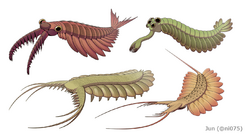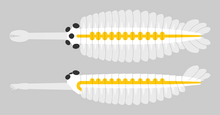Biology:Dinocaridida
| Dinocaridida | |
|---|---|

| |
| Assembly of dinocaridids (Anomalocaris, Opabinia, Pambdelurion and Kerygmachela) | |
| Scientific classification | |
| Domain: | Eukaryota |
| Kingdom: | Animalia |
| Phylum: | Arthropoda |
| Class: | †Dinocaridida Collins, 1996 |
| Subgroups | |
Dinocaridida[derivation 1] is a proposed fossil taxon[1] of basal arthropods that flourished in the Cambrian period with occasional Ordovician[2] and Devonian records.[3] Characterized by a pair of frontal appendages and series of body flaps, the name of Dinocaridids (Greek for deinos "terrible" and Latin for caris "crab") refers to the suggested role of some of these members as the largest marine predators of their time.[1] Dinocaridids are occasionally referred to as the 'AOPK group' by some literatures,[4][5][6] as the group compose of Radiodonta (Anomalocaris and relatives), Opabiniidae (Opabinia and relatives), and the "gilled lobopodians" Pambdelurion and Kerygmachelidae.[7] It is most likely paraphyletic, with Kerygmachelidae and Pambdelurion more basal than the clade compose of Opabiniidae, Radiodonta and other arthropods.[4][8][9]
Anatomy
Dinocaridids were bilaterally symmetrical, with a mostly non-mineralized cuticle and a body divided into two major groupings of tagmata (body-sections): head and trunk. The head apparently unsegmented[8][9] and had a pair of specialized frontal appendages just in front of the mouth and eyes. The frontal appendages are either lobopodous (soft as in gilled lobopodians) or arthropodized (hardened and segmented as in Radiodonta) and usually paired, but highly fused into a nozzle-like structure in Opabiniidae.[7] Based on their preocular position and putative protocerebral origin, the frontal appendages are generally though to be homologous to the labrum of euarthropods and primary antennae of onychophoran,[10][9] while subsequent evidence also suggest a deutocerebral origin (homologous to the jaws of onychophora and great appendages/antennae/chelicerae of euarthropods).[11][12] The trunk possessed multiple segments, each with its own gill branch and swimming flaps (lobes).[13] It is thought that these flaps moved in an up-and-down motion, in order to propel the animal forward[14] in a fashion similar to the cuttlefish. In gilled lobopodian genera, the trunk may have borne a lobopodous limb (lobopod) underneath each of the flaps.[13] The midgut of dinocaridids had paired digestive glands similar to those of siberiid lobopodians and Cambrian euarthropods.[15] The dinocaridid brain is relatively simple than those of an euarthropod (3-segmented), it is thought to be comprised either 1 (only protocerebrum[10][16]) or 2 cerebral ganglions (protocerebrum and deutocerebrum).[12]
Classification
|
Dinocaridida |
Although some authors may rather suggest different taxonomic affinities (e.g. as cycloneuralian relatives[17][7]), most of the phylogenetic studies suggest that dinocaridids are stem group arthropods.[18][19][20][21][13][8][9][22][23][24] Under this scenario, Dinocaridida is a paraphyletic grade in correspond to the arthropod crown group (Euarthropoda or Deuteropoda) and also suggest a lobopodian origin of the arthropod lineage.[25][8] In general, the gilled lobopodian genera Pambdelurion and Kerygmachela which have lobopodian traits (e.g. lobopodous appendage, annulation) occupied the basal position; while Opabiniidae and Radiodonta are more derived and closely related to the arthropod crown group, with the latter even having significant arthropod affinities such as arthropodization and head sclerites.[24][26][8]
In the original description, Dinocaridida was composed of only Opabiniidae and Radiodonta.[1] With the exclusion of questionable taxa (e.g. the putative opabiniid Myoscolex[27]), the former were known only by Opabinia, while all radiodont species were grouped under a single family: Anomalocarididae (hence the previous common name 'Anomalocaridids'[18]). In later studies, the gilled lobopodians Pambdelurion and Kerygmachela were also regarded to be dinocaridids,[7] two new opabiniid genera, Utaurora and Mieridduryn were described,[28][29][30] other strange dinocaridids like Parvibellus (which might actually be a juvenile siberiid lobopodian),[31][29] many radiodonts were reassigned to other new families (Amplectobeluidae, Tamisiocarididae and Hurdiidae),[21] and a new family, Kerygmachelidae,[29] was named.
Distribution
The group was geographically widespread, and has been reported from Cambrian strata in Canada , United States , Greenland, China , Australia and Russia ,[32] as well as the Ordovician of Morocco and Wales[2][33][30] and Devonian of Germany .[3]
Notes
- ↑ Greek for deinos "terrible" and Latin for caris "crab" – sometimes informally spelt Dinocarida, but the second 'id' is linguistically correct – see Hou, Xianguang; Bergström, Jan; Jie, Yang (2006). "Distinguishing anomalocaridids from arthropods and priapulids". Geological Journal 41 (3–4): 259–269. doi:10.1002/gj.1050.
References
- ↑ 1.0 1.1 1.2 Collins, D. (1996). "The "Evolution" of Anomalocaris and Its Classification in the Arthropod Class Dinocarida (nov.) and Order Radiodonta (nov.)". Journal of Paleontology 70 (2): 280–293. doi:10.1017/S0022336000023362. Bibcode: 1996JPal...70..280C.
- ↑ 2.0 2.1 Van Roy, P.; Briggs, D. E. G. (2011). "A giant Ordovician anomalocaridid". Nature 473 (7348): 510–513. doi:10.1038/nature09920. edit
- ↑ 3.0 3.1 Kühl, G.; Briggs, D. E. G.; Rust, J. (Feb 2009). "A Great-Appendage Arthropod with a Radial Mouth from the Lower Devonian Hunsrück Slate, Germany". Science 323 (5915): 771–3. doi:10.1126/science.1166586. ISSN 0036-8075. PMID 19197061. Bibcode: 2009Sci...323..771K.
- ↑ 4.0 4.1 Budd, Graham E. (1998). "The morphology and phylogenetic significance of Kerygmachela kierkegaardi Budd (Buen Formation, Lower Cambrian, N Greenland)" (in en). Earth and Environmental Science Transactions of the Royal Society of Edinburgh 89 (4): 249–290. doi:10.1017/S0263593300002418. ISSN 1473-7116. https://www.cambridge.org/core/journals/earth-and-environmental-science-transactions-of-royal-society-of-edinburgh/article/abs/morphology-and-phylogenetic-significance-of-kerygmachela-kierkegaardi-budd-buen-formation-lower-cambrian-n-greenland/AF165229724342F0BD90933A037CB05F.
- ↑ Liu, Jianni (2004). "A rare lobopod with well-preserved eyes from Chengjiang Lagerstätte and its implications for origin of arthropods" (in en). Chinese Science Bulletin 49 (10): 1063. doi:10.1360/04wd0052. ISSN 1001-6538. Bibcode: 2004ChSBu..49.1063L. https://www.researchgate.net/publication/250967128.
- ↑ "Morpho-anatomy of the lobopod Magadictyon cf. haikouensis from the Early Cambrian Chengjiang Lagerstätte, South China" (in en). Acta Zoologica 89 (2): 183. 2008. doi:10.1111/j.1463-6395.2007.00307.x. ISSN 1463-6395. https://onlinelibrary.wiley.com/doi/abs/10.1111/j.1463-6395.2007.00307.x.
- ↑ 7.0 7.1 7.2 7.3 Xianguang, Hou; Jan, Jan Bergström; Jiayu, In Rong; Zongjie, Fang; Zhanghe, Zhou; Renbin, Zhan; Xiangdong, Wang; Xunlai (eds, Yuan et al. (2006). Dinocaridids – anomalous arthropods or arthropod-like worms?.
- ↑ 8.0 8.1 8.2 8.3 8.4 Ortega‐Hernández, Javier (2016). "Making sense of 'lower' and 'upper' stem-group Euarthropoda, with comments on the strict use of the name Arthropoda von Siebold, 1848" (in en). Biological Reviews 91 (1): 255–273. doi:10.1111/brv.12168. ISSN 1469-185X. PMID 25528950.
- ↑ 9.0 9.1 9.2 9.3 Ortega-Hernández, Javier; Janssen, Ralf; Budd, Graham E. (2017-05-01). "Origin and evolution of the panarthropod head – A palaeobiological and developmental perspective" (in en). Arthropod Structure & Development. Evolution of Segmentation 46 (3): 354–379. doi:10.1016/j.asd.2016.10.011. ISSN 1467-8039. PMID 27989966.
- ↑ 10.0 10.1 Cong, Peiyun; Ma, Xiaoya; Hou, Xianguang; Edgecombe, Gregory D.; Strausfeld, Nicholas J. (2014). "Brain structure resolves the segmental affinity of anomalocaridid appendages" (in en). Nature 513 (7519): 538–542. doi:10.1038/nature13486. ISSN 0028-0836. PMID 25043032. Bibcode: 2014Natur.513..538C. https://www.researchgate.net/publication/263967019.
- ↑ Zeng, Han; Zhao, Fangchen; Niu, Kecheng; Zhu, Maoyan; Huang, Diying (2020). "An early Cambrian euarthropod with radiodont-like raptorial appendages" (in en). Nature 588 (7836): 101–105. doi:10.1038/s41586-020-2883-7. ISSN 1476-4687. PMID 33149303. Bibcode: 2020Natur.588..101Z. https://www.nature.com/articles/s41586-020-2883-7.
- ↑ 12.0 12.1 Moysiuk, Joseph; Caron, Jean-Bernard (2022-08-08). "A three-eyed radiodont with fossilized neuroanatomy informs the origin of the arthropod head and segmentation" (in English). Current Biology 32 (15): 3302–3316.e2. doi:10.1016/j.cub.2022.06.027. ISSN 0960-9822. PMID 35809569. https://www.cell.com/current-biology/abstract/S0960-9822(22)00986-1.
- ↑ 13.0 13.1 13.2 Van Roy, Peter; Daley, Allison C.; Briggs, Derek E. G. (2015). "Anomalocaridid trunk limb homology revealed by a giant filter-feeder with paired flaps" (in en). Nature 522 (7554): 77–80. doi:10.1038/nature14256. ISSN 1476-4687. PMID 25762145. Bibcode: 2015Natur.522...77V. https://www.researchgate.net/publication/273467554.
- ↑ Usami, Y. (2006). "Theoretical study on the body form and swimming pattern of Anomalocaris based on hydrodynamic simulation". Journal of Theoretical Biology 238 (1): 11–17. doi:10.1016/j.jtbi.2005.05.008. PMID 16002096. Bibcode: 2006JThBi.238...11U.
- ↑ Vannier, Jean; Liu, Jianni; Lerosey-Aubril, Rudy; Vinther, Jakob; Daley, Allison C. (2014-05-02). "Sophisticated digestive systems in early arthropods" (in en). Nature Communications 5 (1): 3641. doi:10.1038/ncomms4641. ISSN 2041-1723. PMID 24785191. Bibcode: 2014NatCo...5.3641V.
- ↑ Park, Tae-Yoon S.; Kihm, Ji-Hoon; Woo, Jusun; Park, Changkun; Lee, Won Young; Smith, M. Paul; Harper, David A. T.; Young, Fletcher et al. (2018-03-09). "Brain and eyes of Kerygmachela reveal protocerebral ancestry of the panarthropod head" (in en). Nature Communications 9 (1): 1019. doi:10.1038/s41467-018-03464-w. ISSN 2041-1723. PMID 29523785. Bibcode: 2018NatCo...9.1019P.
- ↑ Xian‐Guang, Hou; Bergström, Jan; Ahlberg, Per (1995-09-01). "Anomalocaris and other large animals in the lower Cambrian Chengjiang fauna of southwest China". GFF 117 (3): 163–183. doi:10.1080/11035899509546213. ISSN 1103-5897.
- ↑ 18.0 18.1 Daley, A. C.; Budd, G. E.; Caron, J.-B.; Edgecombe, G. D.; Collins, D. (2009-03-20). "The Burgess Shale Anomalocaridid Hurdia and Its Significance for Early Euarthropod Evolution" (in en). Science 323 (5921): 1597–1600. doi:10.1126/science.1169514. ISSN 0036-8075. PMID 19299617. Bibcode: 2009Sci...323.1597D. https://www.researchgate.net/publication/24213487.
- ↑ Edgecombe, Gregory D. (2010). "Arthropod phylogeny: an overview from the perspectives of morphology, molecular data and the fossil record". Arthropod Structure & Development 39 (2–3): 74–87. doi:10.1016/j.asd.2009.10.002. ISSN 1873-5495. PMID 19854297.
- ↑ Legg, David A.; Sutton, Mark D.; Edgecombe, Gregory D. (2013). "Arthropod fossil data increase congruence of morphological and molecular phylogenies" (in en). Nature Communications 4 (1): 2485. doi:10.1038/ncomms3485. ISSN 2041-1723. PMID 24077329. Bibcode: 2013NatCo...4.2485L. https://www.researchgate.net/publication/257205419.
- ↑ 21.0 21.1 Vinther, Jakob; Stein, Martin; Longrich, Nicholas R.; Harper, David A. T. (2014). "A suspension-feeding anomalocarid from the Early Cambrian" (in en). Nature 507 (7493): 496–499. doi:10.1038/nature13010. ISSN 1476-4687. PMID 24670770. Bibcode: 2014Natur.507..496V. http://dro.dur.ac.uk/21270/1/21270.pdf.
- ↑ Lerosey-Aubril, Rudy; Pates, Stephen (2018-09-14). "New suspension-feeding radiodont suggests evolution of microplanktivory in Cambrian macronekton" (in en). Nature Communications 9 (1): 3774. doi:10.1038/s41467-018-06229-7. ISSN 2041-1723. PMID 30218075. Bibcode: 2018NatCo...9.3774L.
- ↑ Moysiuk, J.; Caron, J.-B. (2019-08-14). "A new hurdiid radiodont from the Burgess Shale evinces the exploitation of Cambrian infaunal food sources". Proceedings of the Royal Society B: Biological Sciences 286 (1908): 20191079. doi:10.1098/rspb.2019.1079. PMID 31362637.
- ↑ 24.0 24.1 Chipman, Ariel D.; Edgecombe, Gregory D. (2019-10-09). "Developing an integrated understanding of the evolution of arthropod segmentation using fossils and evo-devo". Proceedings of the Royal Society B: Biological Sciences 286 (1912): 20191881. doi:10.1098/rspb.2019.1881. PMID 31575373.
- ↑ Budd, G. E. (1996). "The morphology of Opabinia regalis and the reconstruction of the arthropod stem-group". Lethaia 29: 1–14. doi:10.1111/j.1502-3931.1996.tb01831.x.
- ↑ Ortega-Hernández, Javier (2015-06-15). "Homology of Head Sclerites in Burgess Shale Euarthropods" (in en). Current Biology 25 (12): 1625–1631. doi:10.1016/j.cub.2015.04.034. ISSN 0960-9822. PMID 25959966.
- ↑ Briggs, Derek E. G.; Nedin, Christopher (1997). "The taphonomy and affinities of the problematic fossil Myoscolex from the Lower Cambrian Emu Bay Shale of South Australia" (in en). Journal of Paleontology 71 (1): 22–32. doi:10.1017/S0022336000038919. ISSN 0022-3360. Bibcode: 1997JPal...71...22B. https://www.cambridge.org/core/journals/journal-of-paleontology/article/abs/taphonomy-and-affinities-of-the-problematic-fossil-myoscolex-from-the-lower-cambrian-emu-bay-shale-of-south-australia/A1B81FF5C35D3C63C4AEAC954E025C47.
- ↑ Pates, Stephen; Wolfe, Joanna M.; Lerosey-Aubril, Rudy; Daley, Allison C.; Ortega-Hernández, Javier (2022-02-09). "New opabiniid diversifies the weirdest wonders of the euarthropod stem group". Proceedings of the Royal Society B: Biological Sciences 289 (1968): 20212093. doi:10.1098/rspb.2021.2093. PMID 35135344.
- ↑ 29.0 29.1 29.2 McCall, C. R. A. (2023). "A large pelagic lobopodian from the Cambrian Pioche Shale of Nevada". Journal of Paleontology: 1–16. doi:10.1017/jpa.2023.63.
- ↑ 30.0 30.1 Pates, S.; Botting, J. P.; Muir, L. A.; Wolfe, J. M. (2022). "Ordovician opabiniid-like animals and the role of the proboscis in euarthropod head evolution". Nature Communications 13 (1): 6969. doi:10.1038/s41467-022-34204-w. PMID 36379946. Bibcode: 2022NatCo..13.6969P.
- ↑ Liu, Jianni; Dunlop, Jason A.; Steiner, Michael; Shu, Degan (2022-07-22). "A Cambrian fossil from the Chengjiang fauna sharing characteristics with gilled lobopodians, opabiniids and radiodonts". Frontiers in Earth Science 10: 861934. doi:10.3389/feart.2022.861934. ISSN 2296-6463.
- ↑ Ponomarenko, A. G. (2010). "First record of Dinocarida from Russia". Paleontological Journal 44 (5): 503–504. doi:10.1134/S0031030110050047.
- ↑ Pates, Stephen; Botting, Joseph P.; McCobb, Lucy M. E.; Muir, Lucy A. (2020). "A miniature Ordovician hurdiid from Wales demonstrates the adaptability of Radiodonta". Royal Society Open Science 7 (6): 200459. doi:10.1098/rsos.200459. PMID 32742697. Bibcode: 2020RSOS....700459P.
Wikidata ☰ Q1955055 entry
 |










